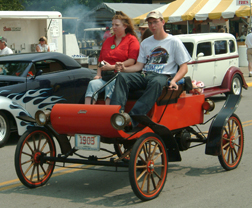
Antique, Classic And Vintage Cars
What Is The Antique Car Era?
Technically, Vintage Car and Classic Car designations cover shorter eras than the Antique era. Antique cars cover the spectrum from pre-vintage cars, through the hot rod era and clear through the muscle car era of the 1960s and mid-1970s. Antique Car, Vintage Car & Classic Car DefinedThe antique car definition includes, of course, all types of vehicles, not just the high-performance cars of interest to hot-rodders. In its 2008 Judging Guidelines, The Antique Automobile Club of America defines an Antique Car as follows:
Today it is commonly accepted that an Antique Car is any vehicle manufactured at least 25 years ago. Most states will issue special license plates for vehicles at least 25 years old, with mileage limitations. Some states have the antique car cutoff as short as ten years old, with certain provisions. Agreement is elusive, however, on what entails a Vintage Car, often defined as any vehicle built between the start of 1919 and the end of 1930. The 1919 start date of the Vintage period is seldom questioned, although early cars such as the fine specimin above, driven through the 2007 Louisville Nationals Exhibition, were manufactured earlier than 1919. These earlier cars would be Antique Cars, if not Vintage Cars. In the strict British definition, 1930 is the cut-off. Some American sources prefer 1925 since it is the pre-classic car period as defined by the Classic Car Club of America. Others consider the start of World War II to be the end of the Vintage period. Some see the Classic Car period as overlapping the Vintage period, especially since the Vintage designation covers all vehicles produced in the period while the official Classic Car Club definition includes only high-end vehicles. The Classic Car Club of America believes it created the term "classic car" and therefore has the right to define it as "a fine or distinctive automobile, either American or foreign built, produced between 1925 and 1948. Generally, a Classic was high-priced when new and was built in limited quantities. Other factors, including engine displacement, custom coachwork and luxury accessories ..." However, many automobile enthusiasts outside of this club hold the less limiting viewpoint that a "classic car" includes any older, very fine and classy vehicle. The 1949 Mercury is considered by many to be the classic car that defined an era and inspired dreams.
OverviewTo put things in perspective, cars were still somewhat rare in 1919. By 1930, they had all but replaced buggies and other forms of primitive transportation. Industrialized nations began building road systems. Cars became more practical and comfortable with the ability to negotiate unpaved roads. Improvements came quickly.
During this period, society became more car-oriented. For example, the drive-in restaurant was conceived. Suburban shopping centers were developed. Motels began lining roads in the United States, as travelers took their vehicles for road trips. On today's crowded, polluted highways, we may feel nostalgia for those times. But most of us would not trade our Prius or Deuce Coup replica to go back in time. And why should we, when we can have all the modern conveniences and still enjoy the romance of eras past?
| ||








